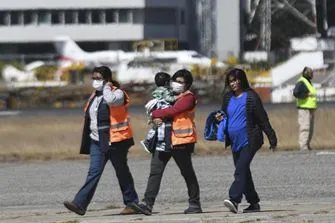Migration and the COVID-19 pandemic in the Northern Triangle of Central America
by Rodolfo E. Herrera M.*)
Migration is key for the livelihoods of thousands of households in Guatemala, Honduras, and El Salvador, which are called the Northern Triangle of Central America. Migration seems to be the only option here in order to escape violence and crime and entire families have become depended on remittances sent by migrants living and working in the United States. Now, the Covid-19 pandemic is severely affecting migrants and their families. On the one hand, migrants in the USA are hardest hit by unemployment, causing a drop in remittances, and on the other, those who are deported back home are being discriminated because people think they might bring Covid-19 along. But, despite the negative outlook, migration flows are likely to continue after the pandemic is over.
Rising unemployment and falling remittances
In the United States, still the main destination country for migrants from the Northern Triangle, the unemployment rate soared up to 14.7% in April 2020. According to the latest report released by the US Bureau of Labor Statistics this is the highest unemployment rate since 1948, when these statistics were first being published.
As this is often the case, the current unemployment rate is even higher for the Hispanic and Latino communities, reaching 18.9%. Undocumented migrants face an even grimmer outlook. Although many of them are considered essential workers, they face barriers to access health care, and are not entitled to receive unemployment benefits, or the cash transfers implemented recently by the federal government.
Meanwhile, in all countries of migrants’ origin, families see remittances fall. The World Bank has estimated that remittances will drop by up to 20% globally, in what they have called “the sharpest decline in recent history”. Estimates for Guatemala, Honduras, and El Salvador indicated a similar decline: around 22% during 2020. This will be a significant blow to households whose incomes largely depend on receiving remittances: In Guatemala, this applies to up to 9% of the total population, and in El Salvador and Honduras up to 18%.
Deportations during the pandemic
Deportations of apprehended migrants from the United States back to their countries of origin continue to take place. The New York Times has reported that along with swift deportations of unaccompanied minors, some deportees have tested positive for Covid-19 during medical checks at arrival points in their home countries. Though put in (self-) quarantine, their return has the potential to accelerate the spread of the virus and put additional pressure on the already fragile public health systems in Central American countries. Moreover, the same report also indicates that deportees have to endure additional stigma now, as many fellow citizens identify them as vectors of the disease.
After the lockdown, migration will continue
With such an adverse scenario, a relevant question is how migrants and their families will cope with the shocks to their livelihoods. Would migrants return to their home countries? Or, on the contrary, could migration increase after the pandemic? Although empirical research will be needed to verify any hypothesis, it is most likely that migration outflows will resume after the pandemic, as long as migration out of the Northern Triangle is mainly driven by economic motives and/or security concerns.
It is true that migrants in the United States face deteriorating income prospects due to the economic downturn, but perspectives are no much better in their countries of origin. According to estimations from the International Monetary Fund, the United States economy will experience a contraction of 5.9% this year, while the economies of the sending countries are expected to see negative growth rates ranging from -2% in the case of Guatemala and Honduras to -5% in El Salvador.
In addition to the bleak economic situation, the threat of violence continues to play a major role too. At the end of April, El Salvador saw a sudden increase in homicides rates, indicating that criminal groups maintain their operative capacity despite the government efforts to control violence and crime.
All in all, thousands of migrants and their families face a discouraging outlook: Unemployment, falling incomes and remittances, the continuous risk of deportation, exposure to Covid-19, and discrimination in their home countries. And still, migration out of the Northern Triangle is likely to continue after the pandemic is over due to aggravating economic conditions and the permanent threat of violence.
*) The author is a Junior Researcher at ZEF




